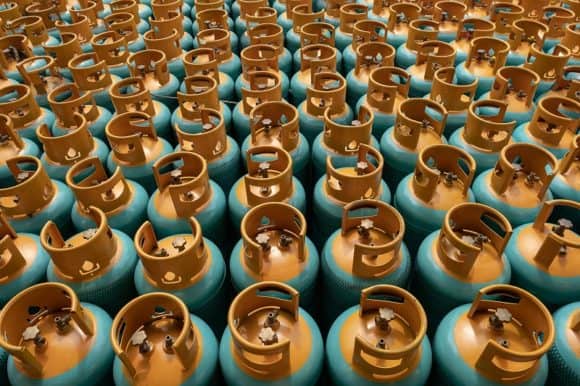Feb 28, 2020 | Air Pollution, Alumni, India, Poverty & Equity, Young Scientists
By Abhishek Kar, Postdoctoral Research Scientist at Columbia University, USA, and IIASA Young Scientists Summer Program (YSSP) alumnus.
Abhishek Kar shares his thoughts on the Indian government’s Ujjwala program, which aims to scale up household access to Liquefied Petroleum Gas (LPG) for clean cooking.

© Kaiskynet | Dreamstime.com
About 2.9 billion people depend on burning traditional fuels like firewood rather than modern cooking fuels like gas and electricity to cook their daily meals. The household air pollution caused when these fuels are burned, along with the resultant exposure to kitchen smoke causes several respiratory and other diseases. It is estimated that between 2 and 3.6 million people die every year due to lack of access to clean cooking fuels. It also has severe environmental effects like forest degradation and contributes to climate change. To address these challenges, the Indian Government launched a massive program called Pradhan Mantri Ujjwala Yojana (PMUY, or Ujjwala) to scale up household access to Liquefied Petroleum Gas (LPG) in May 2016.
My IIASA Young Scientists Summer Program (YSSP) project under Shonali Pachauri’s supervision was about analyzing consumption patterns of LPG in rural India. We looked at whether there was any differences in consumption patterns between the Ujjwala beneficiaries and general consumers. The analysis formed part of my PhD research and was eventually published as the cover story for the September 2019 issue of the journal, Nature Energy. The journal also invited us to write a policy brief, which was published in January 2020. The study’s findings received widespread media attention, especially in India. When I talk to journalists, they often ask whether the Ujjwala program is a success or a failure. I would like to use this opportunity to clear common misconceptions and share my thoughts.
The Ujjwala program’s original mandate was to tackle the challenge of “lack of access to clean fuel” and to make LPG affordable for poor women. The program provided capital subsidies to this end. Unfortunately, the policy document neither discussed usage of LPG as an exclusive or primary cooking fuel, nor did it provide any incentive for regular use (barring the universal LPG cylinder subsidy that is provided to everyone). The program was ambitious in terms of both scale and timeline, and fulfilled its original aim of providing LPG connections for millions of poor women.
Current debates around the program’s failure to result in smokeless kitchens are happening only because Ujjwala succeeded in fulfilling its original mandate of ensuring physical access. In my opinion, it is truly a remarkable achievement to have reached out to 80 million poor women within 40 months. The process not only involved massive awareness generation and community mobilization, but also ramping up the supply chain to meet increased demand. While I have a lot to say about how Ujjwala can be improved, I think it would be unfair to call it a failure. Access is the first step towards transition to clean fuels, and at least in this respect, it was an extraordinary success, making it a model of energy access for developing countries.
Our research shows that Ujjwala was able to attract new consumers rapidly, but those consumers did not start using LPG on a regular basis. Based on the literature and my own experience, there are five reasons why regular LPG use is a challenge for Ujjwala consumers, and the scheme did not have any specific provisions to effectively address them.
First, rural communities generally have easy access to free firewood, crop residues, cattle dung, etc. So why would they start paying for commercial fuel, when free fuel is readily available for cooking?
Secondly, Ujjwala (bravely) targeted poor women, who generally have limited disposable cash and seasonal, agriculture linked fluctuations in income. If there is no additional income, what costs would a poor family on an already tight budget have to cut to afford such a regular additional expense? While the program has made a 5 kg cylinder option available in response to this issue, the impact on LPG sales is still unknown.
Thirdly, home delivery of LPG cylinders is a challenge in most rural areas, as the cost of delivery for LPG distributors often outweighs the commission they receive. If there is no delivery option, poor rural families who often don’t have access to transport would need to arrange for a cylinder to be picked up from a far-off retail outlet. Oil Marketing Companies have vigorously been pushing for home delivery, but unless there are explicit incentives for this, the situation is unlikely to improve.

© Dmitrii Melnikov | Dreamstime.com
In the fourth place, gender dynamics make the situation even more complicated. Men are often financial decision makers who have to make budget cuts, while women are the primary beneficiaries of LPG in terms of a quick and smokeless cooking experience, with the side benefit of avoiding the drudgery of fuelwood collection. The laudable effort of the LPG panchayat platform, where women share their success stories and strategies to overcome opposition within their homes, is a step in the right direction, but it is unlikely that this will be sufficient to tackle a deep-rooted societal problem.
Lastly, and perhaps most importantly, people will have to stop using mud stoves and start using LPG stoves, which may involve real (or, perceived) changes in the taste, texture, look, and size of food items. As a student of habit change literature, I am surprised that anyone expected that such a switch would not be accompanied by behavior change interventions.
Ultimately, the Ujjwala scheme provided incentives to reduce the burden of the capital cost of LPG connections, and poor female consumers responded to it positively. This is a successful first step towards clean cooking energy transition. However, there were no scheme incentives to promote use, except general LPG subsidies, which is available to all, including the urban middle class. Consumers simply decided that the transition to LPG through regular purchase of LPG refills was not worth it, and did not take the next step. I would however not call this a failure of Ujjwala, as that was never the original program objective.
We have to acknowledge that Ujjwala’s phenomenal success in providing access to clean fuel has put the spotlight on its ineffectiveness to ensure sustained regular use. If you ask me, this is a classic case of the glass half-full or half-empty scenario. Or, as my PhD supervisor at the University of British Columbia, Hisham Zerrifi, puts it: “It depends!”
References:
[1] Kar A, Pachauri S, Bailis R, & Zerriffi H (2019). Using sales data to assess cooking gas adoption and the impact of India’s Ujjwala program in rural Karnataka. Nature Energy DOI: 10.1038/s41560-019-0429-8 [pure.iiasa.ac.at/15994]
Note: This article gives the views of the author, and not the position of the Nexus blog, nor of the International Institute for Applied Systems Analysis.
Feb 5, 2020 | Alumni, Climate Change, Science and Policy, Women in Science, Young Scientists
By Leila Niamir, post-doctoral researcher at the Mercator Research Institute on Global Commons and Climate Change (MCC), Germany and IIASA YSSP alumna.

© Cienpies Design Illustrations | Dreamstime
Weather patterns and events are changing and becoming more extreme, sea levels are rising, and greenhouse gas emissions are now at their highest levels in history[1]. Climate change is affecting every individual in every city on every continent. It imposes adverse impact on people, communities, and countries, disrupting regional and national economies.
Climate change mitigation refers to efforts to reduce or prevent emissions of greenhouse gases to limit the magnitude of long-term climate change. Human consumption, in combination with a growing population, contributes to climate change by increasing the rate of greenhouse gas emissions. Over the last decade, instigated by the Paris Agreement, the efforts to limit global warming have been expanding. Significant attention is being devoted to new energy technologies on both the production and consumption sides, however, changes in individual behavior and management practices as part of the mitigation strategy are often neglected[2]. This might derive from the complex nature of human which makes explaining and affecting human behavior a difficult task. As a result, quantitative tools to assess household emissions, considering the diversity of behaviors and a variety of psychological and social factors influencing them beyond purely economic considerations, are scarce. Policymakers would benefit from reliable decision supporting tools that explore the interaction of economic decision-making and behavioral heterogeneity in households behavioral and lifestyle changes, when testing climate mitigation policies (e.g. carbon pricing, subsidies)[3].
To address this issue, during my PhD research I studied the potential of behavioral changes among heterogeneous households regarding energy use and their role in mitigating climate change. By designing and conducting comprehensive household surveys, it was explored how individuals choose to change their energy behaviour and what factors trigger or inhibit these choices[4]. Decision support tools are designed to study large-scale regional effects of individual actions, and to explore how they may change over time and space. The model explicitly treats behavioral triggers and barriers at the individual level, assuming that energy use decision making is a multi-stage process. This theoretically and empirically grounded simulation model offers policymakers ways to explore various policy portfolios by running diverse micro and macro scenarios.
This model was further developed during my collaboration with the IIASA the Young Scientists Summer Program (YSSP), to estimate macro impacts of individuals’ energy behavioral changes on carbon emissions[5]. Within this research, we illustrate that individual energy behavior, especially when amplified through social context, shapes energy demand and, consequently, carbon emissions. Our results show that residential energy demand is strongly linked to personal and social norms. When assessing the cumulative impacts of these behavioral processes, we quantify individual and combined effects of social dynamics and of carbon pricing on individual energy efficiency and on the aggregated regional energy demand and emissions.
In summary, mitigating climate change requires massive worldwide efforts and strong involvement of regions, cities, businesses and individuals, in addition to the commitments at the national levels. We should always keep in mind that every single behavior matters. In the transition to a sustainable and resilient society, we –as individuals- are more than just consumers.
Note: This article gives the views of the author, and not the position of the Nexus blog, nor of the International Institute for Applied Systems Analysis.
[1] Climate Action– United Nations Sustainable Development Goals https://www.un.org/sustainabledevelopment/climate-change/
[2] Creutzig, F., et al. (2018). Towards demand-side solutions for mitigating climate change. Nature Climate Change 8, 268-271; Grubler, A., et al. (2018). A low energy demand scenario for meeting the 1.5 degrees C target and sustainable development goals without negative emission technologies. Nature Energy 3, 515-527; Creutzig, F., et al. (2016). Beyond Technology: Demand-Side Solutions for Climate Change Mitigation. Annual Review of Environment and Resources, Vol 41 41, 173-198
[3] Niamir, L. (2019). Behavioural Climate Change Mitigation: from individual energy choices to demand-side potential (University of Twente); Creutzig, F., et al. (2018). Towards demand-side solutions for mitigating climate change. Nature Climate Change 8, 268-271; Niamir, L., et al. (2018). Transition to low-carbon economy: Assessing cumulative impacts of individual behavioural changes. Energy Policy, 118; Stern N. Economics: Current climate models are grossly misleading. Nature 530(7591):407–9.
[4] Niamir, L. et al. (2020). Demand-side solutions for climate mitigation: Bottom-up drivers of household energy behaviour change in the Netherlands and Spain. Energy Research & Social Science, 62, 101356.
[5] The results of this collaboration was presented at Impacts World 2017 and won the best prize, and also published at Climatic Change Journal.
Dec 10, 2019 | Alumni, IIASA Network, Women in Science
By Luiza Toledo, Science Communication Fellow 2019
Luiza Toledo writes about how the IIASA Women in Science Club are creating a safe space to talk about and advance gender equality in science.
Sustainable Development Goal (SDG) 5 is to achieve gender equality and empower all women and girls. A recent report titled, Harnessing the power of data for gender equality produced by Equal Measures 2030, however, shows that we still have a long way to go before this goal becomes a reality.
Countries in Europe and North America, along with two in the Asia-Pacific region (Australia and New Zealand), achieved the highest scores in terms of gender equality on the 2019 SDG Gender Index. However, even in the 20 top scoring countries, there are still indicators that score low. This suggests that even the countries with high overall scores for gender equality are struggling with thorny issues – one of them being women in science and technology research positions.
As an international institute, IIASA was founded on the principles of equal opportunity, which naturally includes equality in terms of gender balance. The institute’s 2018 Annual Report shows that the number of early-career female IIASA scientists has steadily been growing over the last few years. Since 2016, the number of female researchers increased by 24%, with most of the new hires joining as research assistants. Despite this increasing trend, the gap for PhD level researchers is as high as it has ever been with men outnumbering women four to one. In addition, there is a lack of female scientists in the over-40 age group, which is by no means unique to IIASA. Researchers who study gender and science have even compared women’s careers in science with a leaky pipeline – a flawed channel system that loses quantity before it reaches the destination.

©Liebentritt_Christoph
Even though it is unrealistic to expect a 100% retention of women in science related careers (or any career for that matter), male researchers still have a much higher retention rate in scientific careers than their female colleagues do, and this is where the problem lies. According to the IIASA Diversity and Work Environment Report from 2015, male researchers at IIASA on average stay with the institute for seven years, whereas female researchers stay for only four years. To overcome the leaky pipeline effect, we should start creating a workplace culture that aims to recruit and retain women and is more open to discussing and tackling gender issues in academia, thereby developing a safe networking space.
The Women in Science Club (WISC) at IIASA is a great example of a safe networking space that embraces gender equality and shows the power of women that support other women. Co-led led by Amanda Palazzo, a researcher in the institute’s Ecosystems Services and Management Program, and IIASA Network and Alumni Officer Monika Bauer, the club has a self-proclaimed mission to build a network where women connected to science can share experiences, empower themselves, and highlight the work of other women connected to science.
The idea of creating a network of women in science came about in the fall of 2016 when former Finnish President, Tarja Halonen, visited IIASA. During her visit, she asked to meet with the women of IIASA to talk about diversity and equity issues. This conversation was the first of several meetings that are now attended by women (and men) across the institute under the auspices of WISC.
“The conversation was inspiring and after that first meeting, a few of us thought about organizing a club to continue working on the issues that came up from our discussion with President Halonen,” explains Palazzo.
Nowadays, the WISC organizers arrange lunchtime meetings known as “Meet, greet, and eat” sessions to coincide with visits to IIASA by prominent researchers and other professionals from IIASA and elsewhere who want to share their experiences.
“I’ve found that more experienced and senior women who may have been the only women in their departments at the start of their careers or may have had to fight for a seat at the table are often the quickest to agree to meet with WISC. This shows me that they see the value in a club like ours,” Palazzo adds.
Although the number of women now engaged in science is the highest it has ever been, there are still too few women in positions of leadership. According to Palazzo, at IIASA, this situation is set to change with the institute’s newly appointed Deputy Director General for Science who joined IIASA in November this year.
“I’m excited that Leena Srivastava has joined us and I hope that this is just the start of many changes at IIASA that will bring more women into positions of leadership,” she says.
Palazzo says that the most valuable thing that she has learned so far is that no two women have the same story or path to success.
“I found it reassuring to hear successful women tell us that when they were starting out or even several years into their careers they also didn’t know exactly what contribution they wanted to make. They were learning as they went along. It has also been useful to hear women talk about building resilience to negative comments or behaviors and recognize that these behaviors reflect the other person’s fear and insecurity. In the end, the Women in Science Club is a place to share, contribute, listen, and learn. We want women connected to science to feel that they are a member of our community, that they have a seat at our table, and that they belong here,” she concludes.
Note: This article gives the views of the author, and not the position of the Nexus blog, nor of the International Institute for Applied Systems Analysis.
Oct 28, 2019 | Alumni, Ecosystems, Environment
By Bernd Lenzner, post-doctoral researcher at the Department of Botany and Biodiversity at the University of Vienna, Austria and IIASA YSSP alumnus
To guide action towards a sustainable future for nature and people, it is crucial to understand the role of invasive species in shaping global biodiversity and ecosystem services, as well as how this depends on human actions.
Imagine arriving at the shores of a country you have never visited before. What kind of nature awaits you? Will you be stunned by the beauty of plants and animals you only know from documentaries and books? Will you be fascinated by the songs of birds you’ve never heard before? Or, will you find species you know from your backyard and the landscape surrounding your home?

© Johan Larson | Dreamstime.com
Most of us probably hope to find new, untouched nature with many plants and animals we haven’t encountered yet. Isn’t that after all the purpose of exploring our planet? Unfortunately, nowadays we see that the biota in many regions of the world are becoming more and more similar as a consequence of the movement of species by humans across the globe. Recent studies have shown that approximately 4% of all plants [1], 10% of all birds [2], and 2% of all amphibians and reptiles [3] worldwide can be found in regions outside their native distribution, and these numbers are increasing with no sign of saturation [4]. Once introduced, these so-called alien species can emerge as a major threat to global biodiversity [5] and ecosystem services [6], and lead to global biotic homogenization [7].
We know that these trends are driven not only by the intentional and unintentional human introduction of species into new regions through increased trade and transport, but also by how climate and land use facilitate the establishment of species outside their native range. While these drivers are expected to largely evolve in the decades to come, researchers have so far been unable to build scenarios exploring the long-term dynamics of the distribution of alien species and their impacts.
I lead a joint study between researchers from Vienna University, IIASA, and other colleagues that was recently published in the journal BioScience [8]. In our paper, we introduced the necessary steps for building scenarios of future long-term dynamics of biological invasion at a global scale. We propose a general framework for global 21st century scenarios and models of biological invasions and review essential datasets and milestones. This is the first time that biological invasions are put into a global scenario context with the aim to develop qualitative storylines that can be linked to quantitative models.
I actually started working on this in 2017 when I was still a PhD student in the Division of Conservation Biology, Landscape, and Vegetation Ecology at the University of Vienna, and a participant in the IIASA Young Scientists Summer Program. The project helped to build bridges between research communities deeply involved in core activities from the Intergovernmental Science-Policy Platform on Biodiversity and Ecosystem Services (IPBES).
IIASA was involved in IPBES’ methodological assessment on the use of models and scenarios for biodiversity and ecosystem services and in its efforts to apply biodiversity models in existing IPCC scenarios [9] to deliver insights into the IPBES’ global assessment report released earlier this year. Recently, the IIASA Bending the curve project [10] led by David Leclère, a researcher in the Ecosystems Services and Management Program, used models to elicit what type and ambition of actions are necessary to reverse biodiversity declines, to support on-going discussions at the Convention on Biological Diversity (CBD) on a global international agreement for people and nature to be negotiated in 2020. I am a member of the IPBES expert group involved in the writing of the upcoming thematic assessment on invasive alien species and their control, and also a contributor to a new research project called AlienScenarios funded by BiodivERsA and the Belmont Forum. Led by my supervisor Franz Essl at the University of Vienna, this project will assess global and regional mid- and long-term trends of alien species richness and impacts, as well as develop scenarios for biological invasions.
In the near future, we hope to integrate these on-going projects, to allow better modeling of global biodiversity trends and their drivers, as integrating biological invasions into the global picture are required to materialize the 2050 vision of the Convention on Biological Diversity (CBD).
References
[1] van Kleunen M et al. (2015) Global exchange and accumulation of non-native plants. Nature, 525, 100-103.
[2] Dyer EE, Redding DW, Blackburn TM (2017) The global avian invasions atlas, a database of alien bird distributions worldwide. Scientific Data, 4, 170041.
[3] Capinha C, Seebens H, Cassey P, García-Díaz P, Lenzner B, Mang T, Moser D, Pyšek P, Rödder D, Scalera R, Winter M, Dullinger S, Essl F (2017) Diversity, biogeography and the global flows of alien amphibians and reptiles. Diversity and Distributions, 23, 1313-1322.
[4] Seebens H et al. (2017) No saturation in the accumulation of alien species worldwide. Nature Communications, 8, 14435.
[5] Maxwell SL, Fuller RA, Brooks TM, Watson JEM (2016) Biodiversity: The ravages of guns, nets and bulldozers. Nature, 536, 143-145.
[6] Pejchar L & Mooney HA (2009) Invasive species, ecosystem services and human well-being. Trends in Ecology and Evolution, 9, 497-504.
[7] Capinha C, Essl F, Seebens H, Moser D, Pereira HM (2015) The dispersal of alien species redefines biogeography in the Anthropocene. Science, 348, 1248-1251.
[8] Lenzner B, Leclère D, Franklin O, Seebens H, Roura-Pascual N, Obersteiner M, Dullinger S, Essf F (2019) A framework for global twenty-first century scenarios and models of biological invasions. BioScience, 69, 697-710.
[9] Kim HJ et al. (2018) A protocol for an intercomparison of biodiversity and ecosystem services models using harmonized land-use and climate scenarios. Geoscientific Model Development, 11, 4537-4562.
[10] Leclere D et al. (2018) Towards pathways bending the curve of terrestrial biodiversity trends within the 21st century. IIASA DOI:10.22022/ESM/04-2018.15241.
Note: This article gives the views of the author, and not the position of the Nexus blog, nor of the International Institute for Applied Systems Analysis.
Oct 21, 2019 | Alumni, IIASA Network, Netherlands, Systems Analysis
Leen Hordijk has served in the capacity of project leader, Council member, and director of IIASA. He is currently professor emeritus at Wageningen University and special adviser to the Competence Centre on Modeling at the European Commission’s Joint Research Centre (JRC). He was recently interviewed by IIASA Network and Alumni officer, Monika Bauer.

Leen Hordijk at IIASA in 2006.
In 2007, you wrote an Options article on what systems analysis is in which you stated that systems analysis at IIASA is making an important—even essential—contribution to solving some of the world’s most complex problems. Is the role of systems analysis even more important today, and if so why?
In today’s world, it is indeed more important. First and foremost, the world is more complex than it was 20 years ago. Internet, social media, and the accessibility of transport options make the world more connected and thus more complex. Systems analysis can assist in disentangling the complexities and in trying to quantify where possible. Science is frequently under attack by interest groups, climate change deniers, and even some governments. It is therefore even more important to have an international, multidisciplinary, and multi-cultural institute like IIASA to bring scientific results to policymakers and society. Impartiality and knowledgeability are in the institute’s genes. The world notices this in scientific contributions by IIASA to policy debates in energy, biodiversity, climate change, disaster management, air quality, aging population issues, water management, and technology development.
In my personal development, IIASA has played a key role since my first visit in 1979 when I attended a regional economics conference. “IIASA gets into your blood”, as one of our sons said when I was thinking about applying for the IIASA directorship back in 2001. That is so true for many alumni.
What are your reflections on your time as IIASA Director General?
When I arrived as director in 2002, the challenge was twofold. First, I had to deal with financial issues, as two major members of IIASA had not lived up to their commitments, while expenditures had not been reduced. Second, some ten years after the end of the Cold War, the IIASA membership structure had not changed. The first problem was solved through a thorough 25% expenditure reduction plan and a re-engagement of said members. IIASA staff realized that cuts were necessary, and they were very engaged in finding solutions. The re-engagement of member countries went quickly because of the involvement of Austrian government officials, in particular Raoul Kneucker. The second issue took more time: expanding membership for IIASA to become a global institute rather than an East-West one. With China already on board when I arrived, we expanded membership with Egypt, India, Pakistan, South Africa, and the Republic of Korea.
In terms of content and scientific quality, I was very happy to find an excellent staff. What surprised me was that the number of social scientists (including economists) was higher than I had expected, and the total sum of external financing was quite low. In the following years, most programs became very successful at acquiring projects funded by the European Research Council and various Directorates-General of the European Commission.
Today, IIASA is a major player in terms of providing impartial scientific input in the analysis of many global challenges, such as energy, air quality and climate change, sustainable development, disaster risks, ecosystem services, demography, and technological transitions. IIASA is often a leading institute in signaling global trends and changes and, very importantly, uses its broad systems analytic and modeling capacity to quantify such changes and bring the results to policy fora.
In your opinion, how has the Dutch community benefited from the IIASA network?
It is always very hard to point at such benefits, because more often than not, they cannot be linked to single causes. That aside, I think that the Netherlands’ strength in systems analysis for environment, climate, and energy can, for a substantial part, be linked to leading scientists who spent time at IIASA and/or are active participants in IIASA networks. Last year I came across a nice example when I had a temporary assignment as chief scientist at PBL, the Netherlands Environmental Assessment Agency. In that year, PBL was heavily involved in analyzing a draft national climate agreement for the Dutch government. I met two key scientists in that team who I knew as Young Scientists Summer Program (YSSP) participants during my time as director of IIASA. It was very exciting to notice how they had grown since their time as YSSPers and became essential in the PBL team.
Being part of global scientific networks, gaining experience in advanced interdisciplinary work, and, last but not least, the YSSP, are specific benefits all member countries receive from being a part of IIASA. IIASA was not founded for the benefit of single countries – it is the global good that the institute tries to understand and serve.
I have also personally benefited from being a part of the IIASA network. When I left IIASA in May 2008, I became director of the Institute for Environment and Sustainability of the JRC in Ispra, Italy. IIASA and the JRC have become close collaborators in various fields of research.
More updates from IIASA alumni or information on the IIASA network may be found here.
Note: This article gives the views of the author, and not the position of the Nexus blog, nor of the International Institute for Applied Systems Analysis.
Oct 1, 2019 | Alumni, IIASA Network, Systems Analysis
By Christoph E. Mandl, IIASA alumnus and Senior Lecturer at the University of Natural Resources and Life Sciences in Vienna
Apprehensive about ever growing crises of corporate and political governance, I wrote a book titled, Managing complexity in social systems: Leverage points for policy and strategy, that addresses these crises and appropriate actions from a complex systems, system dynamics, and systems thinking perspective. The premise of the book is that more and more policies and strategies tend to fail and it is based on my personal experiences and the stories of many policymakers.

© Peshkova | Dreamstime
In her disconcerting booklet, The collapse of Western civilization: A view from the future Naomi Oreskes stated: “Analysts agree that the people of Western civilizations knew what was happening to them but were unable to stop it. Indeed, the most startling aspect of this collapse is just how much these people knew, and how unable they were to act upon what they knew.”
So, what can be done about this? How can the complexity of modern societies be managed? Naturally, answers to these questions are anything but trivial. Insights from complexity science, system dynamics, system theory, and systems thinking may not give a full answer but could perhaps point us in the right direction.
In writing my book aimed at closing these societal knowing-doing gaps, four IIASA alumni shaped and influenced my thinking:
The first was Thomas Schelling, who was key for me in showing how, in the context of segregation, a social system’s macro-behavior emerges that is quite different to the micro-motives of the individuals.
Brian Arthur’s book, Increasing returns and path dependence in the economy, revealed to me a totally new perspective on the dynamics of social systems where disequilibrium is not only possible, but normal.
Through John Sterman’s article Bathtub dynamics: Initial results of a systems thinking inventory, I understood how important the distinction between stocks and flows is for decision making in dynamic environments.
Lastly, when I first came across Donella Meadows’ article, Places to intervene in a system, its impact on me was profound. In my view, it was the first publication that addressed decision making from a strictly dynamic point of view. This article and her publication Chicken Little, Cassandra, and the real wolf, forever changed and inspired my thinking about what it means to manage and to make decisions.
Without the insights of these four outstanding IIASA alumni, my book would never have been written. Thank you, IIASA, for bringing them all to Laxenburg!
More updates from IIASA alumni or information on the IIASA network may be found here.
Note: This article gives the views of the author, and not the position of the Nexus blog, nor of the International Institute for Applied Systems Analysis.








You must be logged in to post a comment.